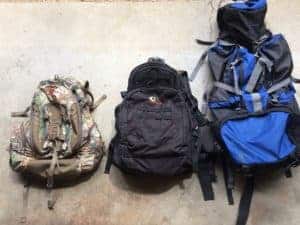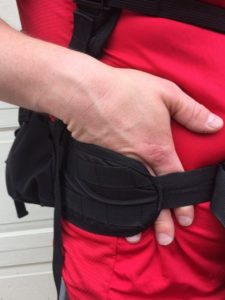For the general fitness enthusiast or the recreational afternoon hiker who is looking to move into all-day or multiple-day hikes, a quality pack is necessary once quality footwear has been addressed. The quality of the pack needed is determined by the load to be carried as well as the length of the hike. When considering a pack to purchase, there several design factors that need to be considered: size of the pack, style of the frame, quality of the material used, and features that make wearing the pack as comfortable as possible. Once these issues have been addressed, fitting the pack correctly for wearing is relatively easy.

Understanding pack size is the most important aspect of picking a pack. The size of the pack will determine how long a hike can last. Packs are typically measured in cubic centimeters (CCs) or liters. When discussing the size of the pack, we are looking at the overall storage area of the pack, typically referred to as the bag. This does not include the size of the frame. As a rule, packs that are 2000cc or smaller are considered day packs. Depending on the quality of a pack, packs this small may or may not have a frame, which helps support heavier loads. Packs this size are comparable to what a middle school-aged child would wear to school. Packs that range in size from 2000-4500cc are typically considered capable of long weekend use. These packs will typically hold enough food, clothing and shelter for 3-4 days of use. An experienced hiker could probably stretch that to almost a week, but that is after taking several multiple day-hiking trips. Almost all packs manufactured in this size range have a frame. A pack bigger than 4500cc is for hiking a week or more. Only those who wish to spend copious amounts of vacation days doing long hikes, like the West Coast or Appalachian Trails, need to consider packs this size.
When it comes to supporting the load a pack can carry, a frame is necessary for anything heavier than around 20 lbs. There are two styles of frames: external frames and internal frames. External frames are visible on the exterior of the bag part of the pack. Internal frames are hidden from view by being built into the bag portion of the pack. Both frame types are typically made from lightweight metal such as aluminum. Really high-end packs sometimes have frames made from higher quality materials such as titanium or carbon fiber. However, for the average person, the price point on these packs is so high that the improvement in quality is not worth the extra money. Using these materials makes the frame lighter without sacrificing durability or comfort. When doing multiple day hikes, ounces saved add up to pounds saved. Saving weight in pack design leads to less physical stress on the body from carrying the pack load. This allows for better duration when hiking miles and a more enjoyable experience.
While the material of the frame is not as great of concern for most people, the material of the bag should be. Cheap packs are made of materials that are often lightweight but have very little durability and will rip easily. Packs made from cotton or fleece can be durable. However, these materials are not waterproof. While a decent daypack could be made from these materials and used when it is not raining, it would be a mistake to buy a multi-day pack made from material that is not waterproof. Nothing ruins a multiday hike like having everything soaking wet. Quality packs are often made from Cordura nylon or heavy polyester fabrics. This lends a waterproofing to durable materials. These types of fabrics are also stronger than cotton or fleece, capable of handling more weight in a smaller pack size than cotton or fleece-based materials. In addition to the size, frame style and material there are several additional features to consider when choosing a pack. Keep in mind that the more features a pack has, the higher the price point will likely be.
Any pack that is going to be considered for more than an afternoon hike should have three nonnegotiable features: a waist belt, adjustable shoulder straps and an adjustable chest strap. When carrying heavy loads in a pack, it is best to settle the weight of a pack low on the hips rather than high on the shoulders. This is impossible without an adjustable waist belt. Packs that only have shoulder straps will put all the pressure of the weight of the pack on the upper back and shoulders, making for an extremely uncomfortable carrying position and greater fatigue when hiking longer than an hour or two. When fitting a pack, always adjust the waist belt first to support most of the weight on the hips. The belt should be snug enough that the pack does not bounce up and down while walking but not so tight that it is uncomfortable on the stomach. Leaving enough room to slip two fingers between the belt and stomach is generally a good fit. Once this is

done, adjust the shoulder straps so that the pack feels snug against the shoulder and is not leaning back to create an uncomfortable backward pull on the shoulders or gap between the pack and the upper back The strap crossing the chest should be the last strap adjusted. The purpose of this strap is to keep the weight balanced across the back so that it does not slide too far to either side of the body. Follow the same adjustment procedure for the shoulder and chest straps as described for the belt.
Proper fitting of a pack belt. Anything tighter will be uncomfortable, while anything looser will not provide proper support to carrying the load.
For packs designed for multiple-day hikes, a couple of other features are nice to have but not required. A storage compartment for a water bladder with a hose makes carrying water and staying hydrated easier and more convenient than carrying multiple water bottles. Small pockets on the waistbelt and shoulder straps make carrying small items such as snacks or a GPS unit readily accessible.
From day packs to multi-day packs, there are a plethora of options available. Most often, people who try hiking with packs and do not enjoy it struggle because they did not take the time to learn how to fit the pack correctly to reduce wear and tear on the body while hiking. Once a person has decided on what type of pack will best meet his or her needs, success lies in learning to wear it correctly. Put in the effort and the scenery will beat any day on the treadmill.
Some loads are more fun than others.

